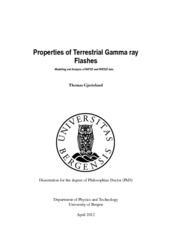| dc.contributor.author | Gjesteland, Thomas | eng |
| dc.date.accessioned | 2012-11-28T11:26:28Z | |
| dc.date.available | 2012-11-28T11:26:28Z | |
| dc.date.issued | 2012-06-15 | eng |
| dc.identifier.isbn | 978-82-308-2060-5 | en_US |
| dc.identifier.uri | https://hdl.handle.net/1956/6203 | |
| dc.description.abstract | This thesis objective is to study Terrestrial Gamma ray Flashes (TGFs), which are short burst (∼ 1 ms) of gamma-radiation from thunderstorms first discovered by Fishman et al. [1994]. The measured photons energies in TGFs are found to be up to several tens of MeV [Smith et al., 2005; Marisaldi et al., 2010a], which make them the most energetic natural photon phenomenon on Earth. The physics behind the production of TGFs are not well established. TGFs are assumed to be bremsstrahlung from relativistic electrons which are accelerated in strong electric fields related to thunderstorms. However, it is not known how frequent TGFs are, what are the altitude range in which they can be produced, the spatial extent of their source region, the angular distribution of the photons at the production altitude or to what kind of thunderstorms and lightning they are related to. There is a few suggested theories of how TGFs can be produced, but there are so far no consensus. The aim of this thesis is to study TGFs in order to understand what this recently discovered natural phenomenon is. In the papers presented in this thesis several questions regarding the nature of TGFs are addressed. The main contributions can be summarized in three points. 1) Determine the production altitude of TGFs. The production altitude will give constraints on the electric fields that produces TGF and which type of lightning and/or thunderstorms that produces TGFs. The production altitude is investigated by comparing Monte Carlo simulations with measurements from the Burst And Transient Source Experiment (BATSE). The conclusions of Paper I [Østgaard et al., 2008] and Paper II [Gjesteland et al., 2010] of this thesis is that the TGFs measured by BATSE are produced in ∼ 10−20 km altitude. 2) Determine the angular distribution of the photons produced in a TGF. The distribution of emitted photons will reflect the direction of the electric fields that produces the TGFs. Paper III [Gjesteland et al., 2011] argue that TGFs are emitted within a cone of 30◦−40◦ indicating that TGFs are produced in nearly vertical electric fields. 3) Examine how common TGFs are. When TGFs were discovered they were thought to be a rare phenomenon since they were only observed ∼ once a month [Fishman et al., 1994]. More recent results based on more sensitive instruments have observed ∼ 10 TGFs a month [Grefenstette et al., 2009], which is more frequent but still rare. Paper IV [Gjesteland et al., 2012] describes a method to lower the sensitivity threshold for the RHESSI satellite. Applying this method has more than double the number of identified TGFs. The increase of identified TGFs indicates that so far only the top of an ’iceberg’ of TGFs are observed. Paper V [Østgaard et al., 2012] use an analytical approach, by comparing the relative TGF count rates of the RHESSI and Fermi satellites, to show that one cannot reject the hypothesis that all lightning produce TGFs. If this is the case, then TGFs are a very common phenomenon which may have important impacts of the coupling between the lower atmosphere and space. This thesis starts with a historical walk trough the TGF research starting almost hundred years ago. Chapter 3 describes the two satellites instruments, BATSE and RHESSI, which are used in the studies of this thesis. Also, a brief overview of other experiments which have measured TGFs are presented. The same chapter also describes radio measurements of lightning which are found to be associated TGFs. Chapter 4 describes the basic theory behind TGFs. In chapter 5 present a brief summary of each of five papers, which is the scientific contribution in this thesis. The five papers are presented in chapter 6. | en_US |
| dc.language.iso | eng | eng |
| dc.publisher | The University of Bergen | en_US |
| dc.relation.haspart | Paper I: Østgaard, N., Gjesteland, T., Stadsnes, J., Connell, P. H . and Carlson, B. (2008) Production altitude and time delays of the terrestrial gamma flashes: Revisiting the Burst and Transient Source Experiment spectra. Journal of Geophysical Research 113, A02307, February 2008. The article is available at: <a href="http://hdl.handle.net/1956/6198" target="blank">http://hdl.handle.net/1956/6198</a> | en_US |
| dc.relation.haspart | Paper II: Gjesteland, T., Østgaard, N., Connell, P. H., Stadsnes, J. and Fishman, G. J. (2010) Effects of dead time losses on terrestrial gamma ray flash measurements with the Burst and Transient Source Experiment. Journal of Geophysical Research 115, A00E21, May 2010. The article is available at: <a href="http://hdl.handle.net/1956/6199" target="blank">http://hdl.handle.net/1956/6199</a> | en_US |
| dc.relation.haspart | Paper III: Gjesteland, T., Østgaard, N., Collier, A. B., Carlson, B. E., Cohen, M. B., Lehtinen, N. G. (2011) Confining the Angular Distribution of Terrestrial Gamma-ray Flash Emission. Journal of Geophysical Research 116, A11313, November 2011. The article is available at: <a href="http://hdl.handle.net/1956/6200" target="blank">http://hdl.handle.net/1956/6200</a> | en_US |
| dc.relation.haspart | Paper IV: Gjesteland, T., Østgaard, N., Collier, A. B., Carlson, B. E., Eyles, C. and Smith, D. M. (2012) A new method reveals more TGFs in the RHESSI data. Geophysical Research Letters 39, L05102, March 2012. The article is available at: <a href="http://hdl.handle.net/1956/6201" target="blank">http://hdl.handle.net/1956/6201</a> | en_US |
| dc.relation.haspart | Paper V: Østgaard, N., Gjesteland, T., Carlson, B. E., Hansen, R. S. and Collier, A. B. (2012) The true fluence distribution of terrestrial gamma flashes at satellite altitude, Journal of Geophysical Research 117,A03327, March 2012. The article is available at: <a href="http://hdl.handle.net/1956/6202" target="blank">http://hdl.handle.net/1956/6202</a> | en_US |
| dc.title | Properties of Terrestrial Gamma ray Flashes. Modelling and Analysis of BATSE and RHESSI data | en_US |
| dc.type | Doctoral thesis | |
| dc.rights.holder | Copyright the author. All rights reserved | en_US |
